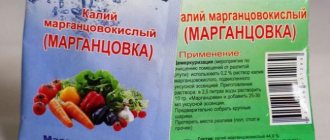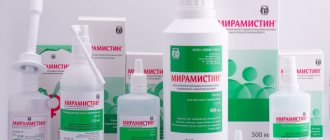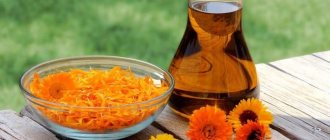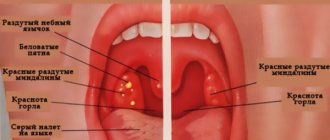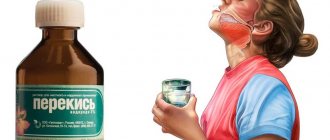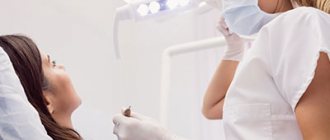Potassium permanganate is an antiseptic proven by many generations, used internally and externally. For ENT diseases and colds, this budget product is used to treat a sore throat. Gargling with potassium permanganate helps relieve pain and effectively washes out harmful microorganisms from the affected mucous membranes . This pharmaceutical product is considered safe and can be used to treat children and adults. To prevent drying out of the mucous membranes, the drug should be used in doses.
Medicinal properties of potassium permanganate
Potassium permanganate (potassium permanganate) is produced in the form of a purple crystalline powder.
Before use, the drug must be diluted in water in compliance with certain proportions. A solution of potassium permanganate has several useful properties:
- Antimicrobial.
- Anti-inflammatory.
- Antiseptic.
- Antifungal.
Potassium permanganate acts as a neutralizer of toxic products released by pathogenic bacteria during their life processes. The product dissolves well in water, after which a specific chemical reaction occurs. As a result of interaction with the liquid, oxygen is released, which causes a pronounced disinfecting effect when a sore throat occurs.
Is it possible to gargle with potassium permanganate?
It is allowed to use potassium permanganate for gargling from the age of 6 years. Its use will bring positive results for various ENT diseases:
- tonsillitis;
- tonsillitis;
- pharyngitis.
With the development of these pathologies, a solution of potassium permanganate will help destroy pathogenic flora and speed up the healing process. The drug disinfects the surface of the tonsils and has drying properties . The product can be used alone or combined with various medications.
Despite the variety of modern antiseptics, potassium permanganate still remains a popular remedy used to combat pathogenic bacteria in various medical fields.
Methods for preparing the medicinal composition
There are various methods of treatment with potassium permanganate solutions. A sore throat will benefit from:
- composition with potassium permanganate and water;
- combination with added iodine;
- alternating a solution of potassium permanganate with hydrogen peroxide.
To prepare the monocomposition, several crystals of potassium permanganate are dissolved in a glass of warm boiled water. The product should acquire a characteristic pale pink color. This solution can be made even more effective by adding no more than 2 drops of iodine to it.
Please note that the solution should be a slightly pale pink color. Just add a few crystals of potassium permanganate and be sure to stir well.
The number of procedures performed during the day is determined by the type of disease. So, gargling with potassium permanganate for sore throat is carried out up to 5 times a day; for scarlet fever, tonsillitis, 2-3 sessions will be enough.
In the case of the development of pharyngitis, purulent laryngitis, a combination of two solutions - potassium permanganate and hydrogen peroxide - has a pronounced therapeutic effect . A weak solution of potassium permanganate is alternated with a peroxide solution (1 tablespoon of the component per glass of non-hot boiled water). This treatment regimen allows you to clear the tonsils and root of the tongue from bacterial plaque.
Before using potassium permanganate solutions for the treatment of ENT diseases, it is necessary to obtain specialist approval. Only an experienced doctor will tell you whether this substance can be present in the general treatment regimen.
Efficiency
Potassium permanganate in the treatment of stomatitis is an effective disinfectant with pronounced:
- antiseptic, drying, wound healing properties;
- the ability to neutralize the toxic effects of microbes on the mucous membrane;
- the ability to prevent pathogens from entering the body through the blood.
If inflammation of the mucous membrane is detected in a timely manner and all recommendations regarding the use of a mouth rinse are followed, stomatitis will go away on the 5th day.
Important nuances of treatment with potassium permanganate solution
During treatment with potassium permanganate solutions, it is important to follow some rules. This will ensure safe use of this substance and eliminate unwanted effects.
During the procedure, you should adhere to the following recommendations:
- To prepare a solution of potassium permanganate, use glass containers (this will help prevent unwanted chemical reactions).
- Do not touch the powder with unprotected hands.
- Make sure that manganese crystals are completely dissolved in water (failure to comply with this point may result in the development of burns to the mucous membrane).
- Use only fresh medicinal composition, renewing it several times a day.
- Sessions should be carried out after meals (at least half an hour later).
- Perform one rinse for 30 seconds, then spit out the liquid.
- Avoid swallowing the medicinal composition.
- After completing the procedure, refrain from consuming any food or drinks for 30-40 minutes.
When rinsing, your head should be tilted back and your tongue should stick out as far forward as possible. In this position, the solution will be able to penetrate deeply into the throat and disinfect the areas of greatest accumulation of bacteria.
The average duration of the entire procedure is about 5 minutes. When preparing the medicinal composition, you should not deviate from the recommended proportions and increase them without permission. Otherwise, the likelihood of developing vomiting, stool disorders (diarrhea), burning in the throat, and sharp spasms in various parts of the abdomen increases. It is also unacceptable to use hot liquid for the procedure - this can lead to the development of burns to the mucous membrane and an increase in body temperature.
The therapeutic effect of rinsing is enhanced by lubricating the tonsils with vegetable oils of sea buckthorn or rose hips. For one treatment you will need at least 1 teaspoon of this product. Oils also help prevent drying out of the mucous membranes.
It is important to know that rinsing with potassium permanganate can negatively affect dental health. In this regard, you can use this product without harm to tooth enamel for no more than 2 days.
Potassium permanganate poisoning
Severe poisoning requires an integrated approach to treatment. The period of hospital stay sometimes reaches 2 months, outpatient follow-up treatment is carried out for 4-6 months. Sometimes the victim requires surgical or resuscitation care. With timely initiation of therapy and the use of recommended methods, complete recovery can be achieved in 90% of cases. The patient is hospitalized in a specialized toxicology center or health care facility, where there is an emergency surgery department and an ICU unit.
Conservative therapy
At the prehospital stage or immediately after delivery to the hospital, lavage is performed through a nasogastric tube. To do this, use a solution made by mixing 100 ml of 3% hydrogen peroxide, 250 ml of 3% acetic acid and 2 liters of cool water. The procedure is continued until the washing composition becomes clean. Visible mucous membranes are treated with ascorbic acid. Under the influence of these agents, the toxicant is converted to harmless compounds. After the procedure, activated carbon is administered at a dose of 1 g/10 kg of weight.
Systemic treatment consists of the administration of complexing antidotes (thetacine-calcium, unithiol). A 5% ascorbic acid solution is prescribed orally in an amount of 50-100 ml/day. Analgesics, sometimes narcotics, are used for pain relief. To reduce swelling of the mucous membranes, the victim is given inhalations of sodium bicarbonate with the addition of local anesthetics. Prevention of infectious complications requires the addition of broad-spectrum antibacterial agents to the treatment regimen.
Resuscitation aid
With the development of shock, cardiovascular, respiratory and multiple organ failure, transfer of the patient to the intensive care unit, where active detoxification methods can be used: exchange blood transfusion, hemodialysis, forced diuresis. In case of shock, the patient is transferred to mechanical ventilation, cardiotonics, glucocorticosteroid hormones, and adrenaline are added. Hypoxia caused by airway obstruction requires a tracheostomy.
Bleeding arising from ulcers of the esophagus and stomach is treated with the use of hemostatic drugs. In the absence of effect from conservative therapy, hemostasis is carried out using the endoscopic method. The damaged area is injected with a solution of adrenaline or cauterized with colloidal silver. Convulsions are an indication for infusion of barbiturates, benzodiazepines and anxiolytics. 24-hour monitoring of the patient's condition using an anesthesiological monitor is necessary.
Surgery
Required for intractable bleeding, perforation of the gastrointestinal tract, volumetric necrosis of the intestine, as well as in the late stages of healing with formed strictures. In the first case, the indication for intervention is profuse or prolonged capillary hemorrhages occurring over a large area of the esophagus. Through holes in the wall of the digestive system are an indication for emergency surgery, since they are usually accompanied by the development of peritonitis, which poses an immediate threat to life. Without help, the mortality rate is 100%.
When tissues die, the need for surgical treatment is due to the functional failure of the digestive system and endotoxicosis, which occurs when the breakdown products of the intestinal wall are released into the blood. Strictures that interfere with the passage of food are eliminated in cases where the narrowing reaches 40-50%. Lesser degrees of stenosis make it possible to refuse surgical correction if the patient observes some dietary restrictions.
Rehabilitation
Prohibitions at the recovery stage mainly relate to nutrition. In the first 2-3 days, fasting or parenteral infusion of protein-lipid mixtures and glucose is recommended. Further feeding is carried out with cold liquid porridges and broths. Their administration is carried out fractionally 5-6 times/day in small portions. By the end of the first week, the patient is allowed to consume enveloping porridges and decoctions based on rice and crushed cereals. The temperature of food should not exceed 20-25° C. Failure to comply with this rule increases the risk of bleeding.
Diet restoration is carried out over a long period of time, for 6 months or more. After discharge from the hospital, you are allowed to eat mashed potatoes that have cooled to 30° C, pureed meat, boiled fish, any soups, and porridges. Harder foods (bread, cheese, raw meat) are introduced into the diet only after the scab has completely drained and the wounds have healed. Until complete recovery, the consumption of alcohol, spicy, pickled foods that injure the esophagus is prohibited.
Contraindications and side effects
Gargling with a solution of potassium permanganate has certain limitations. Contraindications to the use of potassium permanganate include:
- the patient has an individual intolerance to the product;
- the patient's age is less than 6 years;
- thyroid dysfunction;
- period of childbearing and lactation.
Side effects of using manganese-based gargling solutions can manifest themselves in the form of changes in the color of the mucous membranes, swelling, severe pain, and convulsions. If such negative phenomena develop during treatment, the use of solutions should be abandoned.
In case of an overdose of potassium permanganate, pain develops in the oral cavity, esophagus, and stomach. Possible disruption of digestive processes in the form of intestinal upset. In such situations, timely symptomatic treatment should be carried out.
Terms of use
In the fight against stomatitis in the oral cavity, a weak solution of potassium permanganate is one of the most effective. The product disinfects, anesthetizes, and disinfects affected areas, allowing you to get rid of the disease as quickly as possible. Recipe:
- Boil 1 liter of water.
- Add 5-10 powder crystals.
- Stir the solution thoroughly until the product is completely dissolved, otherwise you can cause a burn to the mucous membrane, which will worsen the course of the disease. You should get a slightly pink solution.
- Rinse your mouth every 2 hours. It is especially important to use a mouth rinse after eating or brushing your teeth with toothpaste.
